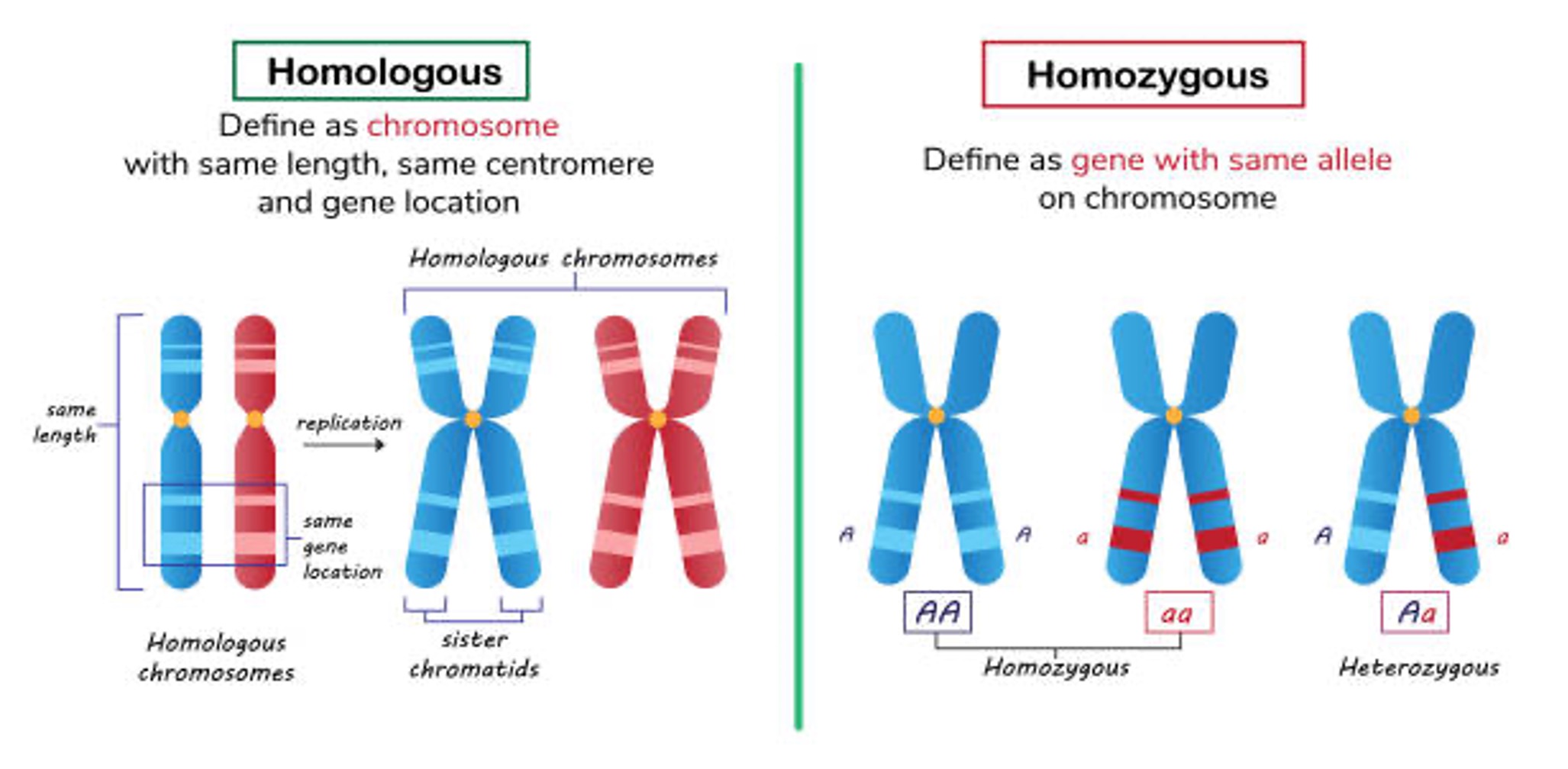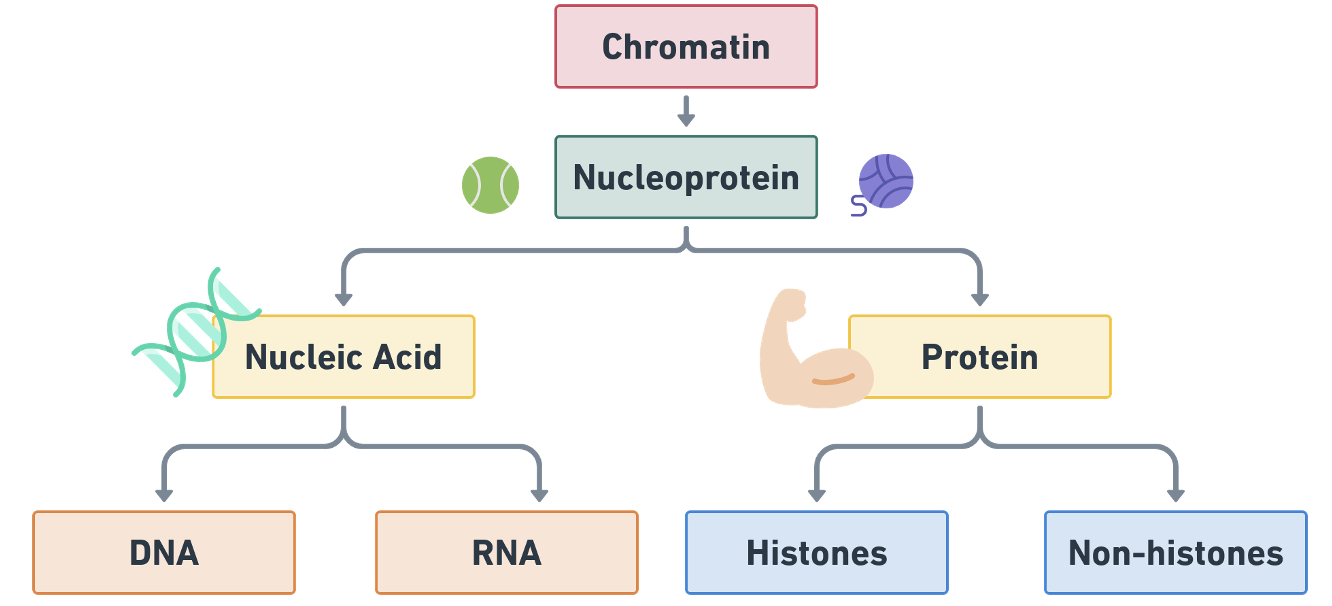🧶 Nucleus
Learn about Nucleus, Chromosomes and Genetic material.
Nucleus
- Nucleus word derived from
Latinword “Kernel”. - Discovery of nucleus:
Robert Brown(1833). - The nucleus is surrounded by a double membrane nuclear envelope (having pores) called nuclear membrane which is chemically lipo-protein.
- The size of nuclei: 5 – 25 µ.
- A true nucleus is absent in bacteria and blue-green algae (cyanobacteria) but nuclear materials are present in them.
- Nucleus is absent in
- Matured mammalian RBCs
- Sieve tube cells in phloem
- Xylem cells (Only a hollow tube that transport water & has no organelle)
- Inside the nuclear membrane there is a colorless dense sap called nuclear sap or nucleoplasm or karyolymph or Karyofluid.
- Inside the nucleoplasm, a tangled mass of threadlike structures is called chromatin.
- Chromatin: made up of DNA + Protein.
- DNA: Deoxyribonucleic acid
- When chromatin condense into rod like bodies during cell division called chromosomes.
- Chromosome contains stretches of DNA. DNA carry information for protein synthesis. The stretches of DNA are called
genes. Genes are passed from parents to the progeny. Hence gene is called hereditary unit and DNA is called hereditary material. Genes control the production of enzymes which guide metabolic activities.
Nucleolus
- A spheroidal and densest organelle in the nucleus is nucleolus.
- Nucleolus contains DNA which synthesizes
ribosomal RNA(Ribonucleic acid). - It is discovered by Fontana (1781). It is rich in RNA but also contains DNA.
- The main function of nucleolus is to synthesize Ribosomal RNA (r RNA). It is attached to the specific site of chromosome which is called ‘nucleolar organizer’.
- In eukaryotes, at least 3 RNA polymerases are present in nucleus viz.
- RNA Polymerase I or A: located in nucleolus, responsible for
r RNA synthesis - RNA Polymerase II or B found in nucleoplasm, responsible for
Hn RNA synthesis(Heterogeneous nuclear RNA) - RNA Polymerase III or C: found in nucleoplasm, responsible for
synthesis of tRNAs or sRNA
- RNA Polymerase I or A: located in nucleolus, responsible for
Chromosome

- Chromosome was first seen by
Strasburgerin 1875 as fine thread. (Discovered) - But the name ‘Chromosome’ (Chroma = colour + soma = body) was first used by
Waldeyerin 1888 using basic dye. - Chromosomes are the carriers of hereditary units i.e. genes. (Given by Morgan) UPPSC 2021
- The chromosome having identical allels for a particular trait is known as
Homozygous. RRB SO 2021

- In all the species, there is a certain no. of chromosomes viz. in human 2n = 46, in rice 2n = 24.
- In Prokaryotes, there is a single chromosome which is circular in shape and is called
genophore(without histone) whereas in eukaryotes chromosomes are rod shaped.

- Nucleic acid is the polymer of nucleotides.
- One nucleotide = Sugar + Nitrogenous base + Phosphate (H3PO4)
- One Nucleoside = Sugar + base only
- Nucleotide = Nucleoside + Phosphoric acid
- Nitrogenous bases are:
- A → Adenine
- G → Guanine
- C → Cytosine
- T → Thymine
- U → Uracil
- Such bases are ringed structure.
- Purines: Two rings e.g. A, G
- Pyrimidines: Single ring e.g. T, U, C
- J.D. Watson & F.H.C. Crick (1953): proposed a model of DNA comprising of two helically intertwined chains tied together by hydrogen bonds, between the purines & pyrimidines called Double Helix Model of DNA.
- Wilkins: X-ray diffraction of DNA.
- In 1962 Watson, Crick & Wilkins got a Nobel Prize for their studies on the structure of DNA.
Nucleus
- Nucleus word derived from
Latinword “Kernel”. - Discovery of nucleus:
Robert Brown(1833). - The nucleus is surrounded by a double membrane nuclear envelope (having pores) called nuclear membrane which is chemically lipo-protein.
- The size of nuclei: 5 – 25 µ.
- A true nucleus is absent in bacteria and blue-green algae (cyanobacteria) but nuclear materials are present in them.
- Nucleus is absent in
- Matured mammalian RBCs
- Sieve tube cells in phloem
- Xylem cells (Only a hollow tube that transport water & has no organelle)
- Inside the nuclear membrane there is a colorless dense sap called nuclear sap or nucleoplasm or karyolymph or Karyofluid.
- Inside the nucleoplasm, a tangled mass of threadlike structures is called chromatin.
- Chromatin: made up of DNA + Protein.
- DNA: Deoxyribonucleic …
Become Successful With AgriDots
Learn the essential skills for getting a seat in the Exam with
🦄 You are a pro member!
Only use this page if purchasing a gift or enterprise account
Plan
Rs
- Unlimited access to PRO courses
- Quizzes with hand-picked meme prizes
- Invite to private Discord chat
- Free Sticker emailed
Lifetime
Rs
1,499
once
- All PRO-tier benefits
- Single payment, lifetime access
- 4,200 bonus xp points
- Next Level
T-shirt shipped worldwide

Yo! You just found a 20% discount using 👉 EASTEREGG

High-quality fitted cotton shirt produced by Next Level Apparel